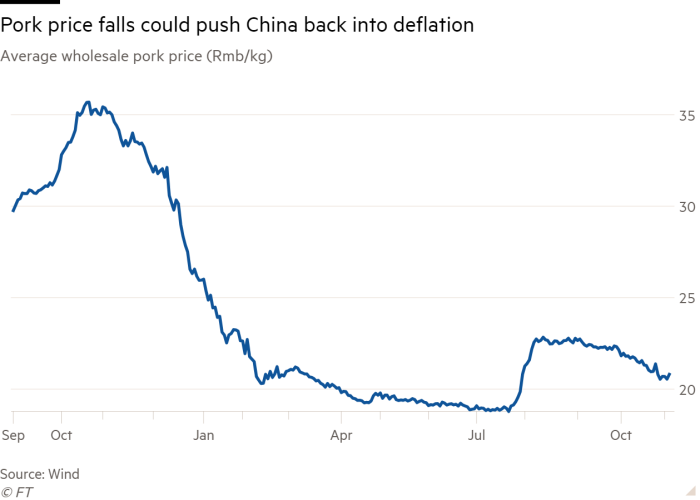Unlock the Editor’s Digest for free
Roula Khalaf, Editor of the FT, selects her favourite stories in this weekly newsletter.
Tumbling pork prices could push China back into deflation this week, as the largest listed hog farmers flood the domestic market and complicate Beijing’s efforts to bolster confidence in the world’s second-largest economy.
Live hog futures traded on China’s Dalian Commodity Exchange have dropped about 15 per cent since the start of October, reflecting a sharp deterioration in expectations for nationwide pork prices. Wholesale pork prices in China are down more than 40 per cent from a year ago.
Economists said the falling cost of pork, with its heavy weighting in China’s official consumer price index, is likely to tip the country back into deflation when October data is released on Thursday.
“It looks like [consumer inflation] will turn negative again in October, and the main reason for that looks to have been a decline in food inflation caused by the fall in pork prices,” said Julian Evans-Pritchard, senior China economist at Capital Economics.
A return to deflation — after anaemic growth in August and a flat CPI reading in September — would undercut officials’ efforts to restore confidence in China’s economy, which remains in a fragile state due to weak consumer confidence and a liquidity crisis in the country’s property sector.
The price of pork in China, which is the world’s largest producer and consumer, has long followed a boom-and-bust cycle as smaller farmers pile into the market in response to rising demand. That leads to oversupply and triggers sharp price falls, forcing the same farmers to retreat.

Beijing has sought to exert greater control over this cycle by concentrating more production in a handful of large-scale farming outfits. However, this year, those same producers have exacerbated price falls.
Pork prices began to rebound in July — partly in response to government-led buying — only to fall back again as large listed hog farmers, including Muyuan and New Hope, opted not to cut capacity despite broader weakness in demand.
Large producers typically lower output by selling off breeding sows and buying fewer piglets to raise until demand pushes up prices again. But Chinese piglet prices are down just 10 per cent from a year ago, suggesting demand for young pigs remains relatively strong despite pork prices dropping by far more.
Analysts said this strategy paid off last year when a recovery for pork prices in the fourth quarter — as China ended its harsh zero-Covid restrictions — ultimately helped top producers boost revenues at the expense of smaller farmers, who were forced out of the market.
Darin Friedrichs, director of market research at Sitonia Consulting in Shanghai, said large Chinese pork producers were running the same strategy this year, but there were no signs of an imminent fourth-quarter rebound in demand.
“It looks like they’re trying to just stick it out again,” Friedrichs said. “But some [pork producers] are selling subsidiaries or making executives buy back stock. That indicates there’s more financial pressure on them.”
Muyuan, the world’s largest hog farmer, is down more than 20 per cent this year, even after executives announced a share buyback worth about Rmb1bn ($137mn) last month. The company was recently forced to cancel a planned share sale in Zurich, blaming unspecified “objective factors”, in a filing to Shenzhen’s stock exchange.
“Part of the problem is that a lot of these big companies have on some level accepted the boom-and-bust cycle,” Friedrichs said. “And they think they’re better at playing it than their competitors.”


Leave a Reply